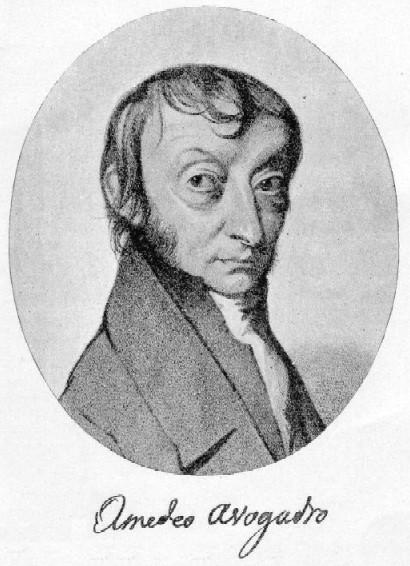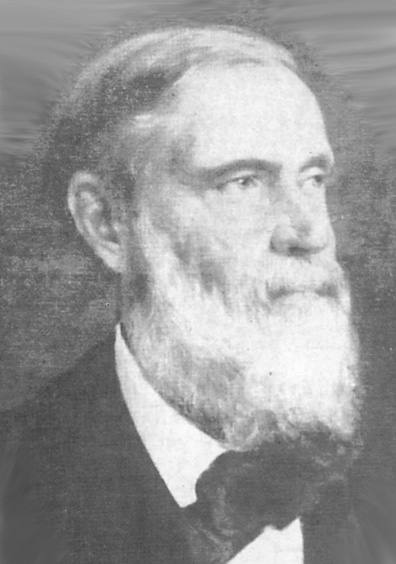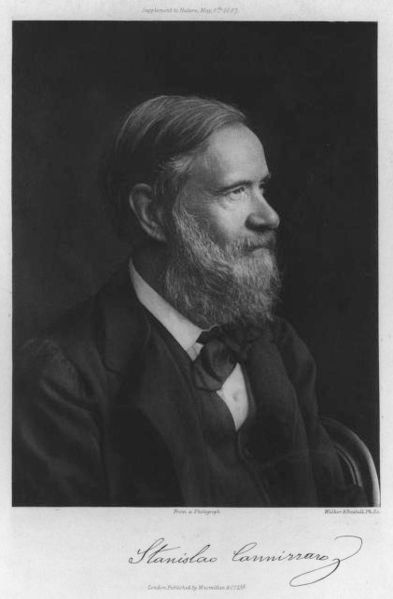<Back to Index>
- Physicist and Chemist Lorenzo Romano Amedeo Carlo Avogadro di Quaregna e di Cerreto, 1776
- Chemist Stanislao Cannizzaro, 1826
PAGE SPONSOR

Lorenzo Romano Amedeo Carlo Avogadro di Quaregna e di Cerreto, Count of Quaregna and Cerreto (9 August 1776, Turin, Piedmont – 9 July 1856) was an Italian savant. He is most noted for his contributions to molecular theory, including what is known as Avogadro's law. In tribute to him, the number of elementary entities (atoms, molecules, ions or other particles) in 1 mole of a substance, 6.02214179(30)×1023, is known as the Avogadro constant.
Amedeo Carlo Avogadro was born in Turin, Italy in 1776 to a noble family of Piedmont, Italy.
He graduated in ecclesiastical law at the early age of 20 and began to practice. Soon after, he dedicated himself to physics and mathematics (then called positive philosophy), and in 1809 started teaching them at a liceo (high school) in Vercelli, where his family had property.
In 1811, he published an article with the title Essai d'une manière de déterminer les masses relatives des molécules élémentaires des corps, et les proportions selon lesquelles elles entrent dans ces combinaisons ("Essay on Determining the Relative Masses of the Elementary Molecules of Bodies and the Proportions by Which They Enter These Combinations"), which contains Avogadro's hypothesis. Avogadro submitted this essay to a French journal, De Lamétherie's Journal de Physique, de Chimie et d'Histoire naturelle (Journal of Physics, Chemistry and Natural History) so it was written in French, not Italian. (Note: In 1811, northern Italy was under the rule of the French Emperor Napoléon Bonaparte.)
In 1820, he became professor of physics at the University of Turin. After the downfall of Napoléon in 1815, northern Italy came under control of this kingdom.
He was active in the revolutionary movements of 1821 against the king of Sardinia (who became ruler of Piedmont with Turin as his capital). As a result, he lost his chair in 1823 (or the university officially declared, it was "very glad to allow this interesting scientist to take a rest from heavy teaching duties, in order to be able to give better attention to his researches").
Eventually, Charles Albert granted a Constitution (Statuto Albertino) in 1848. Well before this, Avogadro had been recalled to the university in Turin in 1833, where he taught for another twenty years.
Little is known about Avogadro's private life, which appears to have been sober and religious. He married Felicita Mazzé and had six children.
Some historians suggest that he sponsored some Sardinian revolutionaries, who were stopped by the announcement of Charles Albert's constitution.
Avogadro held posts dealing with statistics, meteorology, and weights and measures (he introduced the metric system into Piedmont) and was a member of the Royal Superior Council on Public Instruction.
In honor of Avogadro's contributions to molecular theory, the number of molecules in one mole was named Avogadro's number, NA or "Avogadro's constant". It is approximately 6.0221415 × 1023. Avogadro's number is used to compute the results of chemical reactions. It allows chemists to determine amounts of substances produced in a given reaction to a great degree of accuracy.
Johann Josef Loschmidt first calculated the value of Avogadro's number, often referred to as the Loschmidt number in German speaking countries (Loschmidt constant now has another meaning).
Avogadro's Law states that the relationship between the masses of the same volume of different gases (at the same temperature and pressure) corresponds to the relationship between their respective molecular weights. Hence, the relative molecular mass of a gas can be calculated from the mass of sample of known volume.
Avogadro developed this hypothesis after Joseph Louis Gay - Lussac had published in 1808 his law on volumes (and combining gases). The greatest problem Avogadro had to resolve was the confusion at that time regarding atoms and molecules. One of his most important contributions was clearly distinguishing one from the other, stating that gases are composed of molecules, and these molecules are composed of atoms. For instance, John Dalton did not consider this possibility. Avogadro did not actually use the word "atom" as the words "atom" and "molecule" were used almost without difference. He believed that there were three kinds of "molecules," including an "elementary molecule" (our "atom"). Also, more attention was given to the definition of mass, as distinguished from weight.
In 1815, he published Mémoire sur les masses relatives des molécules des corps simples, ou densités présumées de leur gaz, et sur la constitution de quelques - uns de leur composés, pour servir de suite à l'Essai sur le même sujet, publié dans le Journal de Physique, juillet 1811 ("Note on the Relative Masses of Elementary Molecules, or Suggested Densities of Their Gases, and on the Constituents of Some of Their Compounds, As a Follow-up to the Essay on the Same Subject, Published in the Journal of Physics, July 1811"), about gas densities.
In 1821 he published another paper, Nouvelles considérations sur la théorie des proportions déterminées dans les combinaisons, et sur la détermination des masses des molécules des corps (New Considerations on the Theory of Proportions Determined in Combinations, and on Determination of the Masses of Atoms) and shortly afterwards, Mémoire sur la manière de ramener les composès organiques aux lois ordinaires des proportions déterminées (Note on the Manner of Finding the Organic Composition by the Ordinary Laws of Determined Proportions).
In 1841, he published his work in Fisica dei corpi ponderabili, ossia Trattato della costituzione materiale de' corpi, 4 volumes.
The scientific community did not give great attention to his theory, so Avogadro's hypothesis was not immediately accepted. André - Marie Ampère achieved the same results three years later by another method (in his Sur la détermination des proportions dans lesquelles les corps se combinent d'après le nombre et la disposition respective des molécules dont leurs particules intégrantes sont composées -- On the Determination of Proportions in which Bodies Combine According to the Number and the Respective Disposition of the Molecules by Which Their Integral Particles Are Made), but the same indifference was shown to his theory as well.
Only through studies by Charles Frédéric Gerhardt and Auguste Laurent on organic chemistry was it possible to demonstrate that Avogadro's law explained why the same quantities of molecules in a gas have the same volume.
Unfortunately, related experiments with some inorganic substances showed seeming exceptions to the law. This was finally resolved by Stanislao Cannizzaro, as announced at Karlsruhe Congress in 1860, four years after Avogadro's death. He explained that these exceptions were due to molecular dissociations at certain temperatures, and that Avogadro's law determined not only molecular masses, but atomic masses as well.
In 1911, a meeting in Turin commemorated the hundredth anniversary of the publication of Avogadro's classic 1811 paper. King Victor Emmanuel III attended. Thus, Avogadro's great contribution to chemistry was recognized.
Rudolf Clausius, with his kinetic theory on gases, gave another confirmation of Avogadro's Law. Jacobus Henricus van 't Hoff showed that Avogadro's theory also held in dilute solutions.
Avogadro is hailed as a founder of the atomic - molecular theory.


Stanislao Cannizzaro, FRS (July 13, 1826 – May 10, 1910) was an Italian chemist. He is remembered today largely for the Cannizzaro reaction and for his influential role in the atomic weight deliberations of the Karlsruhe Congress in 1860.
Cannizzaro was born in Palermo. In 1841, he entered the university there with the intention of making medicine his profession, but he soon turned to the study of chemistry. In 1845 and 1846, he acted as assistant to Raffaele Piria (1815 – 1865), known for his work on salicin, and who was then professor of chemistry at Pisa and subsequently occupied the same position at Turin.
During the Sicilian revolution of independence of 1848, Cannizzaro served as an artillery officer at Messina and was also chosen deputy for Francavilla in the Sicilian parliament; and, after the fall of Messina in September 1848, he was stationed at Taormina. On the collapse of the insurgents, Cannizzaro escaped to Marseille in May 1849, and, after visiting various French towns, reached Paris in October. There he gained an introduction to Michel Eugène Chevreul's laboratory, and in conjunction with F.S. Cloez (1817 – 1883) made his first contribution to chemical research, in 1851, when they prepared cyanamide by the action of ammonia on cyanogen chloride in ethereal solution. In the same year, Cannizzaro accepted an appointment at the National College of Alessandria, Piedmont, as professor of physical chemistry. In Alessandria, he discovered that aromatic aldehydes are decomposed by an alcoholic solution of potassium hydroxide into a mixture of the corresponding acid and alcohol. For example, benzaldehyde decomposes into benzoic acid and benzyl alcohol, the Cannizzaro reaction.
In the autumn of 1855, Cannizzaro became professor of chemistry at the University of Genoa, and, after further professorships at Pisa and Naples, he accepted the chair of inorganic and organic chemistry at Palermo. There, he spent ten years studying aromatic compounds and continuing to work on amines, until in 1871 when he was appointed to the chair of chemistry at the University of Rome.
Apart from his work on organic chemistry, which includes also an investigation of santonin, Cannizzaro rendered great service to chemistry with his 1858 paper Sunto di un corso di Filosofia chimica, or Sketch of a course of chemical philosophy, in which he insisted on the distinction, previously hypothesized by Avogadro, between atomic and molecular weights. Cannizzaro showed how the atomic weights of elements contained in volatile compounds can be deduced from the molecular weights of those compounds, and how the atomic weights of elements of whose compounds the vapor densities are unknown can be determined from a knowledge of their specific heats. For these achievements, of fundamental importance to atomic theory, he was awarded the Copley Medal by the Royal Society in 1891.
In 1871, Cannizzaro's scientific eminence secured him admission to the Italian senate, of which he was vice - president, and as a member of the Council of Public Instruction and in other ways he rendered important services to the cause of scientific education in Italy.
He is best known for his contribution to the then - existing debate over atoms, molecules, and atomic weights. He championed Amedeo Avogadro's notion that equal volumes of gas at the same pressure and temperature held equal numbers of molecules or atoms, and the notion that equal volumes of gas could be used to calculate atomic weights. In so doing, Cannizzaro provided a new understanding of chemistry.